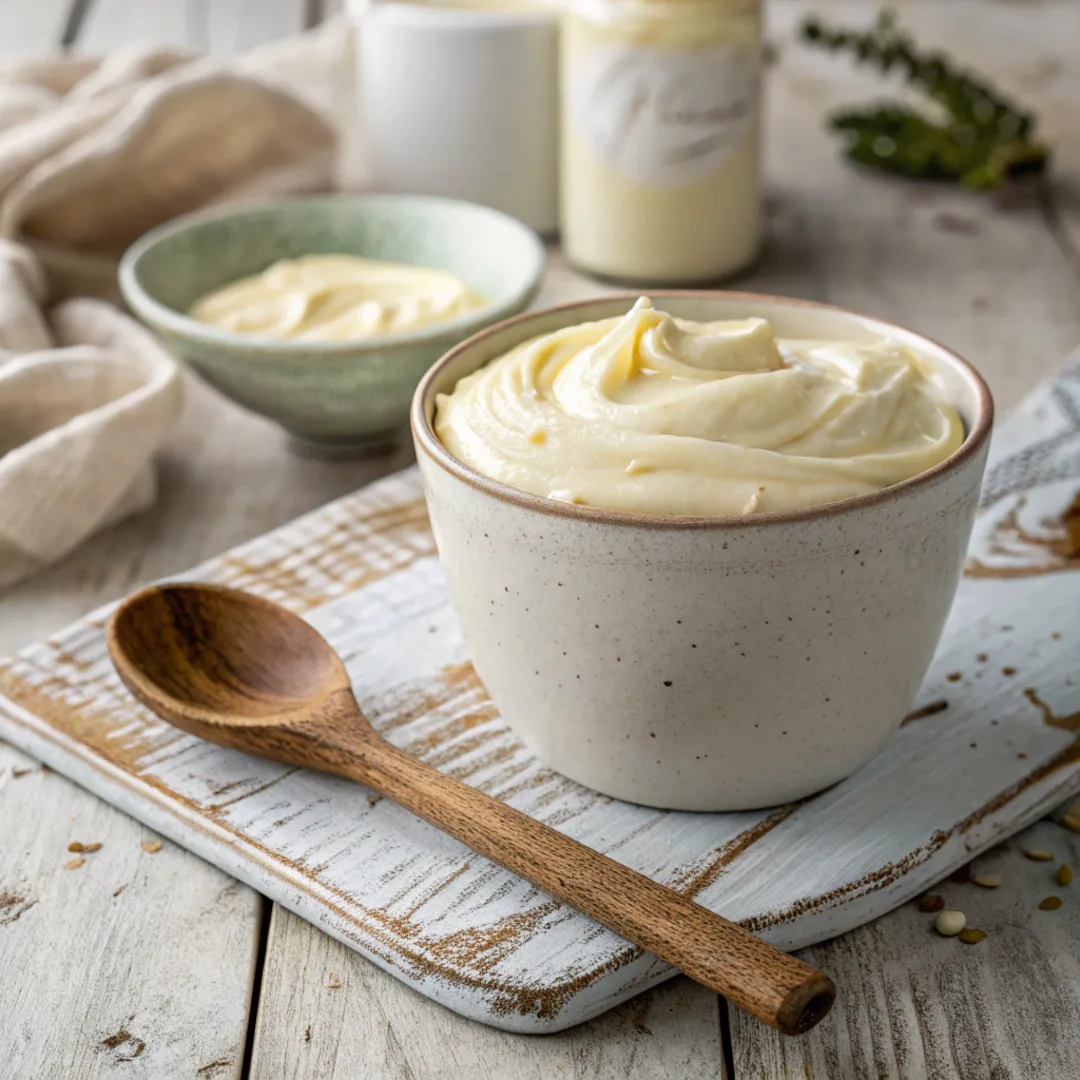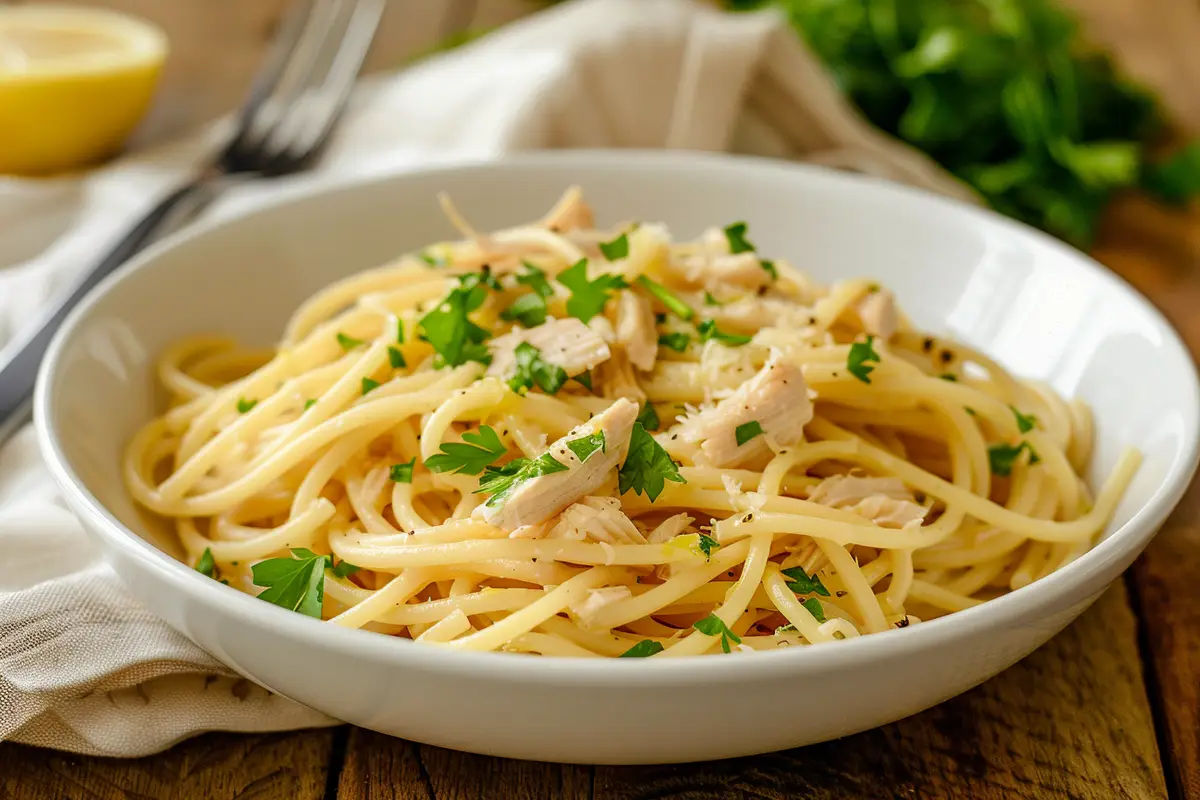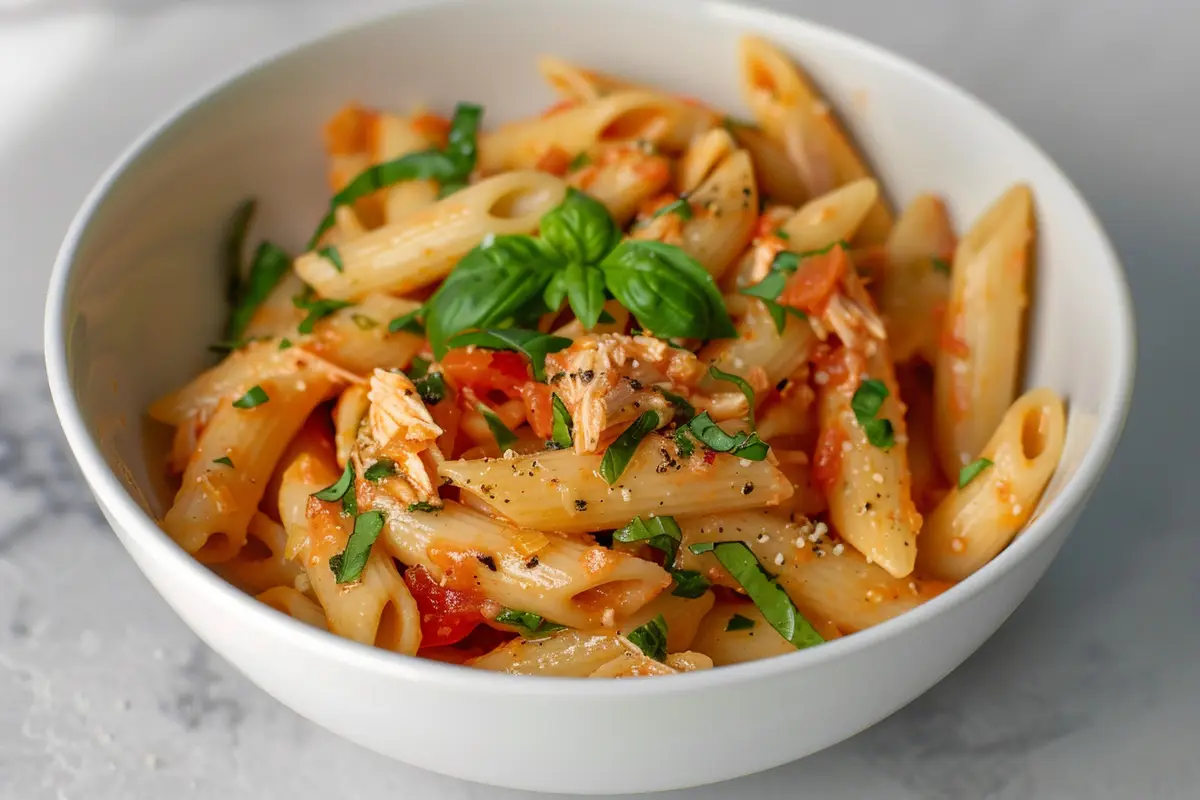Vegan mayo is the perfect alternative for those seeking a healthier, egg-free, and plant-based condiment. It’s creamy, versatile, and just as delicious as traditional mayonnaise. Whether you’re using it for sandwiches, salads, or as a dip, a vegan mayo recipe is easy to make at home with just a few simple ingredients. In this guide, you’ll learn what makes vegan mayo unique, discover the essential ingredients, and get step-by-step instructions for preparing the best vegan mayo recipe from scratch.
Table of Contents

Vegan Mayo Recipe: How to Make the Best Creamy Plant-Based Mayo
- Total Time: 10 minutes
- Yield: 1 cup of vegan mayo 1x
Description
This Homemade Vegan Mayo is creamy, delicious, and the perfect plant-based alternative to traditional mayonnaise. Made with aquafaba (chickpea liquid) as the base, this vegan condiment is rich, tangy, and incredibly easy to make at home. Perfect for spreading on sandwiches, mixing into salads, or serving as a dip, this mayo is also customizable with your favorite herbs and spices.
Ingredients
- ½ cup aquafaba (liquid from canned chickpeas)
- 1 cup neutral oil (such as sunflower, grapeseed, or avocado oil)
- 1 tablespoon lemon juice
- 1 teaspoon mustard (Dijon or yellow)
- ½ teaspoon salt
- Optional: 1 teaspoon maple syrup or agave (for a touch of sweetness)
Instructions
- Prepare Ingredients: Measure and gather all ingredients for easy access.
- Blend the Base: Add aquafaba, lemon juice, mustard, and salt to a high-speed blender. Blend on medium speed for 30 seconds until well combined.
- Emulsify Slowly: With the blender running, slowly drizzle in the oil. Continue blending until the mixture thickens into a creamy, mayonnaise-like consistency.
- Taste and Adjust: Taste the mayo and adjust seasoning if needed. Add more salt or lemon juice for tanginess, or a touch of sweetener for balance.
- Store: Transfer the mayo to an airtight container and refrigerate for up to 1 week.
Notes
- Flavor Variations: Add roasted garlic for garlic aioli, sriracha for a spicy kick, or fresh herbs like dill or basil for an herby twist.
- Storage Tips: Keep your vegan mayo in an airtight glass jar in the refrigerator. Consume within 5-7 days.
- Troubleshooting: If the mayo is runny, add more oil while blending to thicken it. Chill and re-blend if needed.
- Prep Time: 10 minutes
- Cook Time: 0 minutes
- Category: simply savory
- Method: Condiment, Spread
- Cuisine: Vegan, Plant-Based
Nutrition
- Serving Size: 1 tablespoon
- Calories: ~ 90
- Fat: ~10g
- Carbohydrates: ~0.5g
- Protein: ~0.5g
Understanding Vegan Mayo
What is Vegan Mayo?
Vegan mayo is a plant-based version of traditional mayonnaise, replacing eggs with ingredients like aquafaba (chickpea water), tofu, or flaxseed gel. It maintains the same creamy texture and tangy flavor without any animal products, making it suitable for vegans or those with egg allergies.
Why Choose a Vegan Mayo Recipe?
- Health Benefits: Lower in cholesterol and saturated fats compared to regular mayo.
- Dietary Flexibility: Suitable for vegans, vegetarians, and those with food allergies.
- Customizable Flavors: Add herbs, spices, or citrus for a personalized touch.
Popular Uses of Vegan Mayo
- As a spread for sandwiches and wraps.
- A base for salad dressings and dips.
- A flavorful topping for roasted vegetables or grain bowls.
Essential Ingredients for Vegan Mayo Recipe
Core Ingredients in a Vegan Mayo Recipe
The success of your vegan mayo recipe depends on a few key ingredients that provide structure and flavor:
- Aquafaba: The liquid from canned chickpeas acts as a perfect egg substitute.
- Neutral Oil: Use oils like sunflower, grapeseed, or avocado for a creamy texture.
- Lemon Juice or Vinegar: Adds the tangy kick essential to mayonnaise.
- Mustard: Helps emulsify and enhances the flavor.
- Salt and Sweeteners: Balances the taste.
Substitutes for Eggs in Vegan Mayo
Finding the right egg substitute is crucial for a creamy vegan mayo recipe:
- Aquafaba: Whips into a light and airy consistency, mimicking egg whites.
- Silken Tofu: Creates a rich, thick texture perfect for mayo.
- Flaxseed Gel: A natural thickener that adds body to the mayo.
How to Make Vegan Mayo Recipe
Step-by-Step Guide
Follow these steps to create the perfect vegan mayo recipe:
- Prepare Your Ingredients:
Measure ½ cup of aquafaba, 1 cup of neutral oil, 1 tablespoon of lemon juice, 1 teaspoon of mustard, and ½ teaspoon of salt. - Blend the Base:
In a high-speed blender, combine aquafaba, lemon juice, mustard, and salt. Blend for 30 seconds until well mixed. - Emulsify Slowly:
While blending, slowly drizzle in the oil. Continue blending until the mixture thickens and reaches a creamy consistency. - Taste and Adjust:
Add more salt or lemon juice if needed. For a sweeter flavor, a pinch of sugar can be added.
Tips for Success
- Use Cold Ingredients: This helps with emulsification.
- Don’t Rush the Oil: Slowly adding the oil is key to achieving the right texture.
- Store Properly: Keep your vegan mayo in an airtight container in the fridge for up to a week.
Common Problems and How to Fix Them
Even the best vegan mayo recipe can run into problems. Here are some common issues and how to fix them:
How to Fix Runny Vegan Mayo
A runny mayo is usually caused by incorrect oil-to-liquid ratios or insufficient emulsification. Here’s how to fix it:
- Add More Oil Slowly: Continue blending and slowly drizzle in more oil until it thickens.
- Chill and Blend Again: Place the runny mayo in the refrigerator for 30 minutes, then blend it again.
- Use a Thickener: Add a small amount of silken tofu or blended cashews for extra thickness.
Why Vegan Mayo Separates
Separation can occur when the ingredients aren’t properly emulsified. To prevent this:
- Use an Immersion Blender: It helps maintain consistency better than a traditional blender.
- Add Ingredients at the Right Time: Always blend the liquid ingredients first and drizzle in the oil slowly.
- Store Correctly: Keep it in an airtight container and avoid temperature fluctuations.
Preventing an Oily Texture
Sometimes vegan mayo can end up overly oily. To avoid this:
- Use light oils like grapeseed or canola.
- Blend at medium speed to avoid breaking the emulsion.
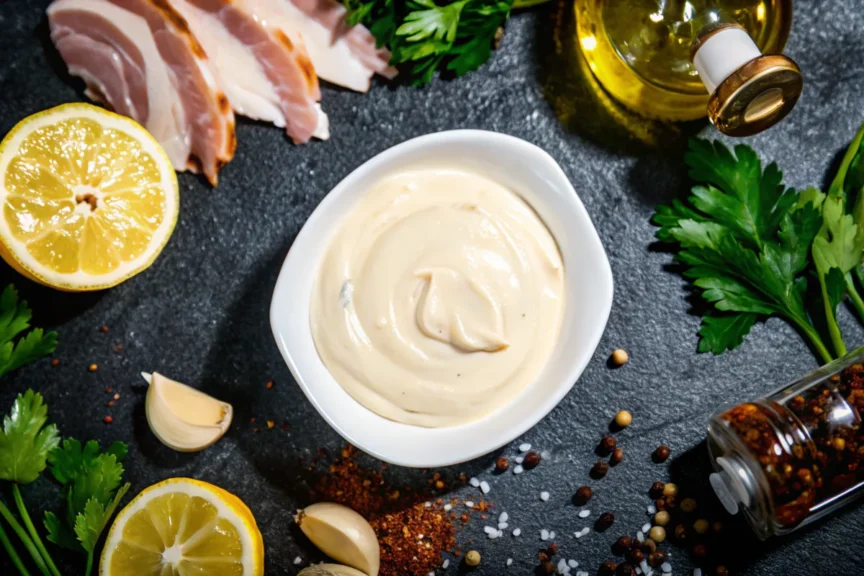
Flavor Variations for Vegan Mayo Recipe
One of the best things about making your own vegan mayo recipe is the endless possibilities for flavor customization. Here are some creative ways to enhance it:
Spicy and Savory Variations
- Sriracha Mayo: Add 1 tablespoon of sriracha for a spicy kick.
- Garlic Aioli: Blend in 2 cloves of roasted garlic for a rich flavor.
- Chipotle Mayo: Add 1 teaspoon of chipotle powder or adobo sauce for a smoky taste.
Herb-Infused Vegan Mayo
- Basil Mayo: Blend in fresh basil leaves for a fragrant and herbal note.
- Cilantro Lime Mayo: Add cilantro and lime juice for a zesty twist, perfect for tacos.
- Dill and Cucumber Mayo: Great for sandwiches or as a dip for vegetables.
Sweet Variations
- Honey Mustard Vegan Mayo: Mix in 1 tablespoon of maple syrup and mustard for a sweet and tangy combo.
- Coconut Mayo: Replace part of the oil with coconut oil for a tropical touch.
Health and Nutritional Benefits of Vegan Mayo
Choosing a vegan mayo recipe isn’t just about avoiding animal products—it can also be a healthier option.
Is Vegan Mayo Healthier Than Regular Mayo?
Yes! Here’s why:
- Lower in Saturated Fat: Vegan mayo typically uses heart-healthy oils.
- Cholesterol-Free: Since it’s egg-free, there’s no cholesterol.
- Rich in Plant-Based Nutrients: Depending on the ingredients, you can add nutrients like omega-3s.
Choosing the Healthiest Ingredients
- Use Avocado Oil or Olive Oil: These are high in healthy fats and antioxidants.
- Avoid Refined Oils: Stick to cold-pressed, unrefined oils for better nutrition.
- Limit Sweeteners: If you prefer a slightly sweet mayo, use natural sweeteners like agave or maple syrup.
Portion Control
Even though vegan mayo is healthier, it’s still calorie-dense. Use it in moderation as part of a balanced diet.
Creative Ways to Use Vegan Mayo
Your freshly made vegan mayo recipe can be used in countless ways to elevate meals. Here are some creative and delicious ideas:
As a Spread
- Sandwiches and Wraps: Spread vegan mayo on bread or wraps for a creamy texture.
- Burgers: Add a dollop to veggie burgers for extra flavor.
- Paninis and Grilled Cheese: Use it as a spread before grilling for a crispy, golden crust.
In Salads and Dressings
- Potato Salad: Replace traditional mayo with vegan mayo for a lighter, plant-based version.
- Coleslaw: Use vegan mayo as the base for a creamy slaw dressing.
- Caesar Dressing: Combine it with lemon juice, garlic, and nutritional yeast for a vegan Caesar dressing.
As a Dip or Sauce
- Veggie Dip: Mix with herbs and spices for a quick vegetable dip.
- Fries or Sweet Potato Wedges: Use it as a flavorful dipping sauce.
- Tacos: Drizzle on tacos for an extra layer of creaminess.
FAQ Section
What is a substitute for egg in mayonnaise?
- Aquafaba (the liquid from canned chickpeas) is the most popular egg substitute. Other options include flaxseed gel and silken tofu, which help create a creamy texture similar to traditional mayo.
Is vegan mayo healthier?
- Yes, vegan mayo is often healthier because it’s free from cholesterol and lower in saturated fat. Using healthy oils can also boost its nutritional value. However, it’s still a calorie-dense condiment, so enjoy it in moderation.
What makes mayo not vegan?
- Traditional mayonnaise contains eggs, which are an animal product. Some store-bought varieties may also include preservatives or thickeners derived from animal sources.
What is the best substitute for eggs?
- The best egg substitute for mayo is aquafaba because of its ability to emulsify like egg whites. Silken tofu and flaxseed gel are also great alternatives, depending on the texture you want to achieve.
How to fix runny vegan mayo?
- To thicken runny vegan mayo, continue blending while adding more oil slowly. You can also refrigerate it for 30 minutes or add a thickening agent like blended cashews or silken tofu.
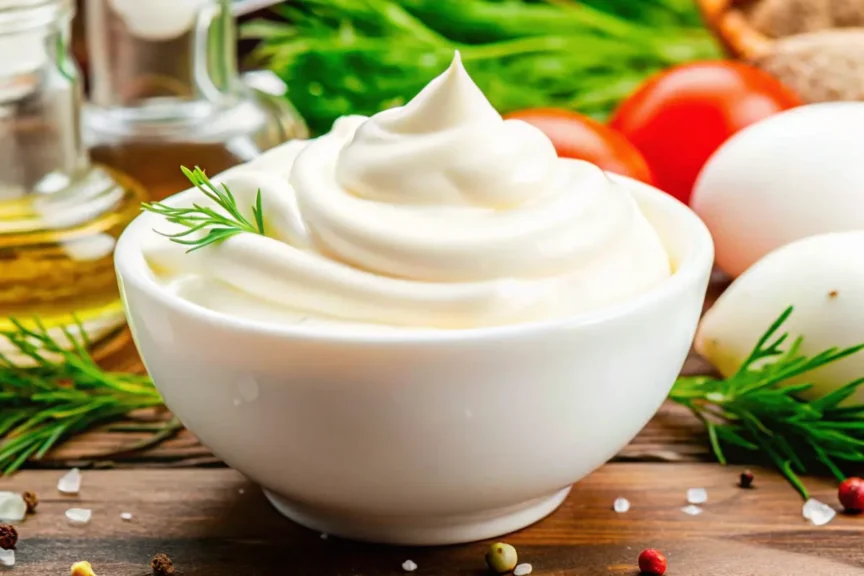
for more vegen recipes visit The Best Ethiopian Vegan Food Recipes
Storing and Preserving Vegan Mayo
Proper storage is essential to maintain the freshness and quality of your homemade vegan mayo recipe.
Storage Tips
- Refrigerate Immediately: Keep your vegan mayo in an airtight container in the refrigerator.
- Use a Glass Jar: Glass containers help preserve flavor and freshness better than plastic.
- Label and Date: Homemade mayo should be consumed within 5 to 7 days. Always label the jar with the date it was made.
Can You Freeze Vegan Mayo?
- While traditional mayo doesn’t freeze well, vegan mayo made with aquafaba and neutral oil can be frozen for up to 2 months. Just thaw it in the refrigerator and blend it again to restore consistency.
Signs Your Vegan Mayo Has Gone Bad
- Color Change: Discoloration is a clear sign that the mayo has spoiled.
- Off Smell: If it smells sour or unpleasant, it’s time to toss it.
- Separation: Some separation is normal, but if it becomes watery or clumpy, it may have gone bad.
Conclusion
Creating your own vegan mayo recipe at home is a fun and rewarding way to enjoy a plant-based version of this classic condiment. With endless possibilities for flavors and uses, it’s a must-have in any vegan kitchen. Try different variations, use it creatively, and enjoy the health benefits of a homemade vegan mayo that’s both delicious and versatile.
Plant-Based Eating Guide –16 Fresh, Flavorful Vegan Salad Dressing Recipes

